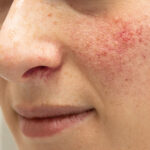
I was thrilled to have taken part in summer 2020 in an event called Black Skin Decoded, with Glamour Magazine. The evening event had a number of experts with skin of colour and I was delighted to have been asked along to offer my input on skin. As a GMC-registered consultant dermatologist, I have trained in all issues related to skin at a high level; working in London through many different hospitals over the years has meant exposure to all colours of skin due to the diversity of the population. Alongside this, independent sector work means seeing skin problems which one would not necessarily be exposed to in the NHS, as many conditions may be considered “cosmetic” rather than “medical” and therefore not meet NHS referral requirements. So let’s talk a little bit about some interesting facts about black skin.
What is it that makes black skin black?
Well, interestingly, everyone (regardless of their skin colour) has the same number of pigment-producing cells (melanocytes) in their skin. However, skin colour differences arise from melanosomes (organelles found inside cells which synthesise, store and transport melanin or pigment). It is the shape, number, size, and aggregation or spread of melanosomes throughout the epidermis which creates variations in skin colour.
What are some differences between black skin and white skin?
1. The upper layer of the epidermis (stratum corneum) has more layers in black skin, even though all skin types have the same stratum corneum thickness; black skin stratum corneum is packed in more compactly, which explains this finding.
2. Black skin has less ceramide in the epidermis.
3. Black skin has a lower level of vitamin D production.
4. Black skin has a more compact and thicker dermis with numerous, large fibroblasts (collagen-producing cells which give the skin support and structure).
5. Black skin has larger melanosomes spread throughout the epidermis.
6. Black skin has a protective factor for UVB of 13.4 (compared to white skin which is 3.4).
So what are some of the main implications of these structural and functional differences?
- Increased melanin content means lower rates of skin cancer compared to white skin.
- Spreading out of melanosomes throughout the epidermis means less damage from sunlight (due to absorption by melanin) and therefore less pronounced skin ageing. However, the flip side is also an increased predisposition to problems with pigmentation which are frequently seen in clinic.
- Larger fibroblasts mean a higher risk for a specific type of scar known as a keloid scar due to abnormal collagen deposition after trauma.
Black Skin and Melanoma
Melanoma in black skin often tends to present later to a dermatologist and has worse survival rates compared to melanoma in white skin. A specific type of melanoma known as acral lentiginous melanoma is the common type seen in black skin. This type of melanoma occurs on the palms or soles and usually starts as a patch of discoloured skin. It is not believed to be related to sun exposure so wearing sunscreen at these sites will not reduce the risk of this specific type of melanoma. It is important to remain vigilant and keep an eye on these areas for discolouration, moles or other non-healing patches of skin and seek advice early from either your GP or dermatologist if you notice something is amiss.
Ageing and black skin
Black skin shows signs of ageing much later than white skin. Facial wrinkles may not develop until one’s 50s or 60s. It is not common to see lines around the mouth (perioral lines) or loss of lip volume when compared to Caucasians. The ageing process often starts in the middle part of the face due to changes in facial fat resulting in deepening of the nose to mouth lines (nasolabial folds) and hollowing under the eyes. Filler is often needed to address these changes rather than wrinkle injections such as Botox.
In summary
Whilst on some levels, skin is the same regardless of its colour, there are some unique differences when it comes to diagnosis and treatment of black skin. Events such as this one are excellent in getting these discussions into the open and bringing to attention something dermatologists have long recognised when treating their patients. Skin will behave differently with certain treatments (e.g. peels and lasers, and individual concerns, will also be different). I am always grateful to have the opportunity to talk about these things on a wider platform and spread the knowledge!





